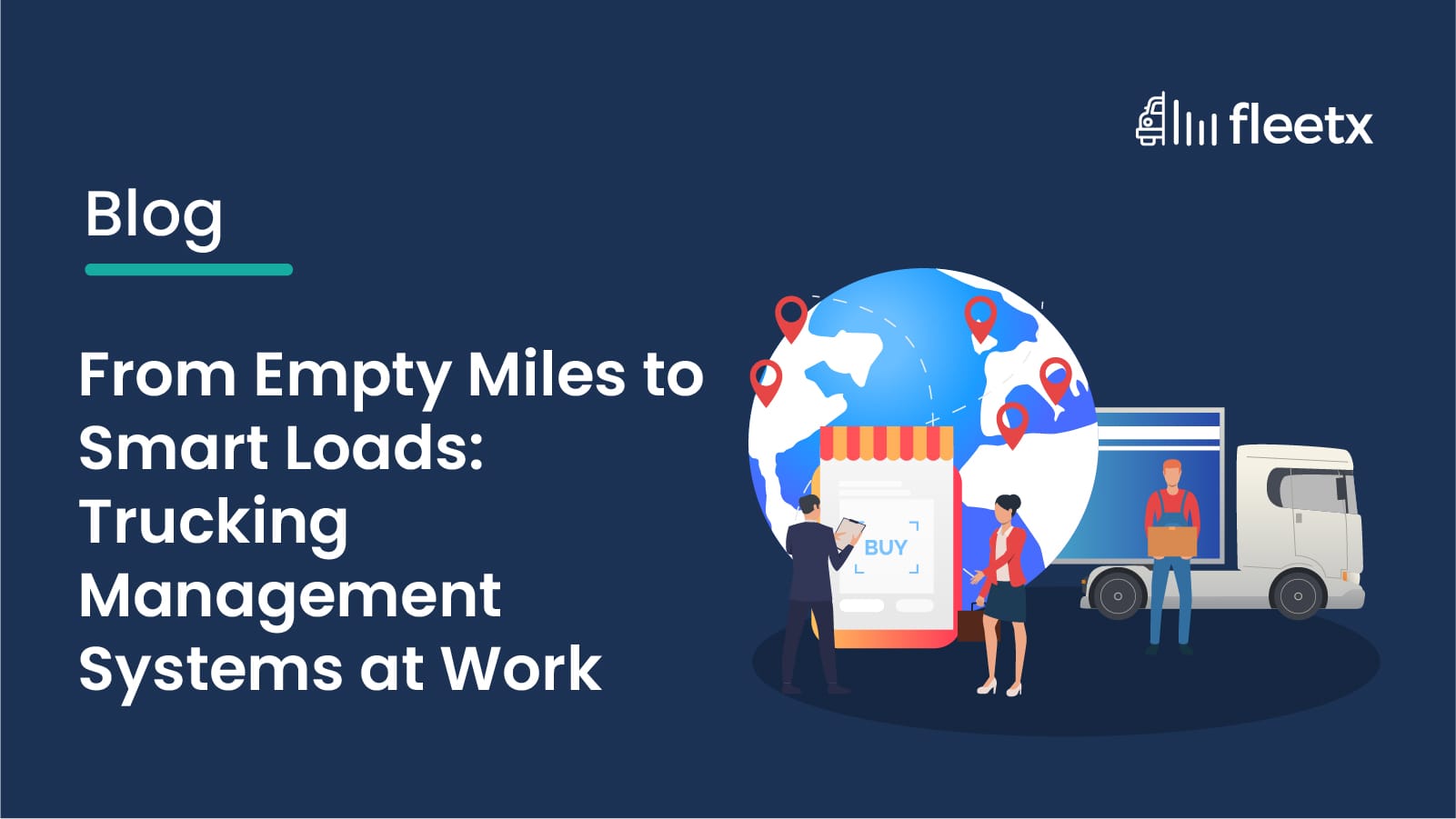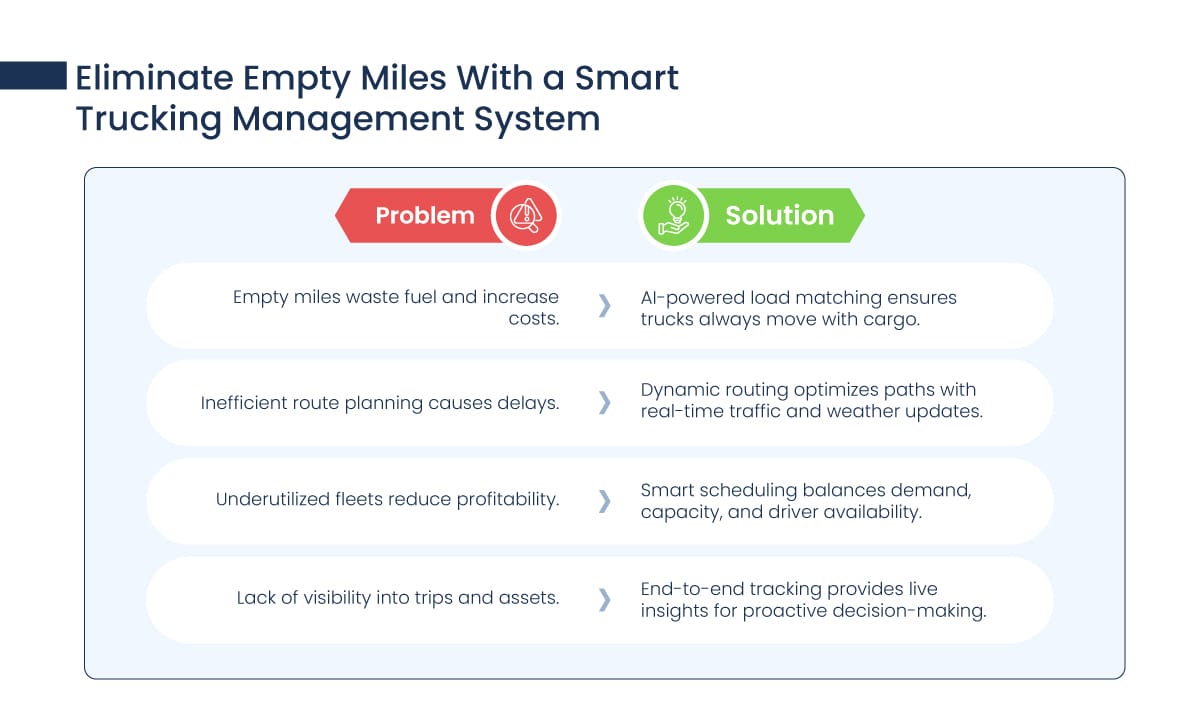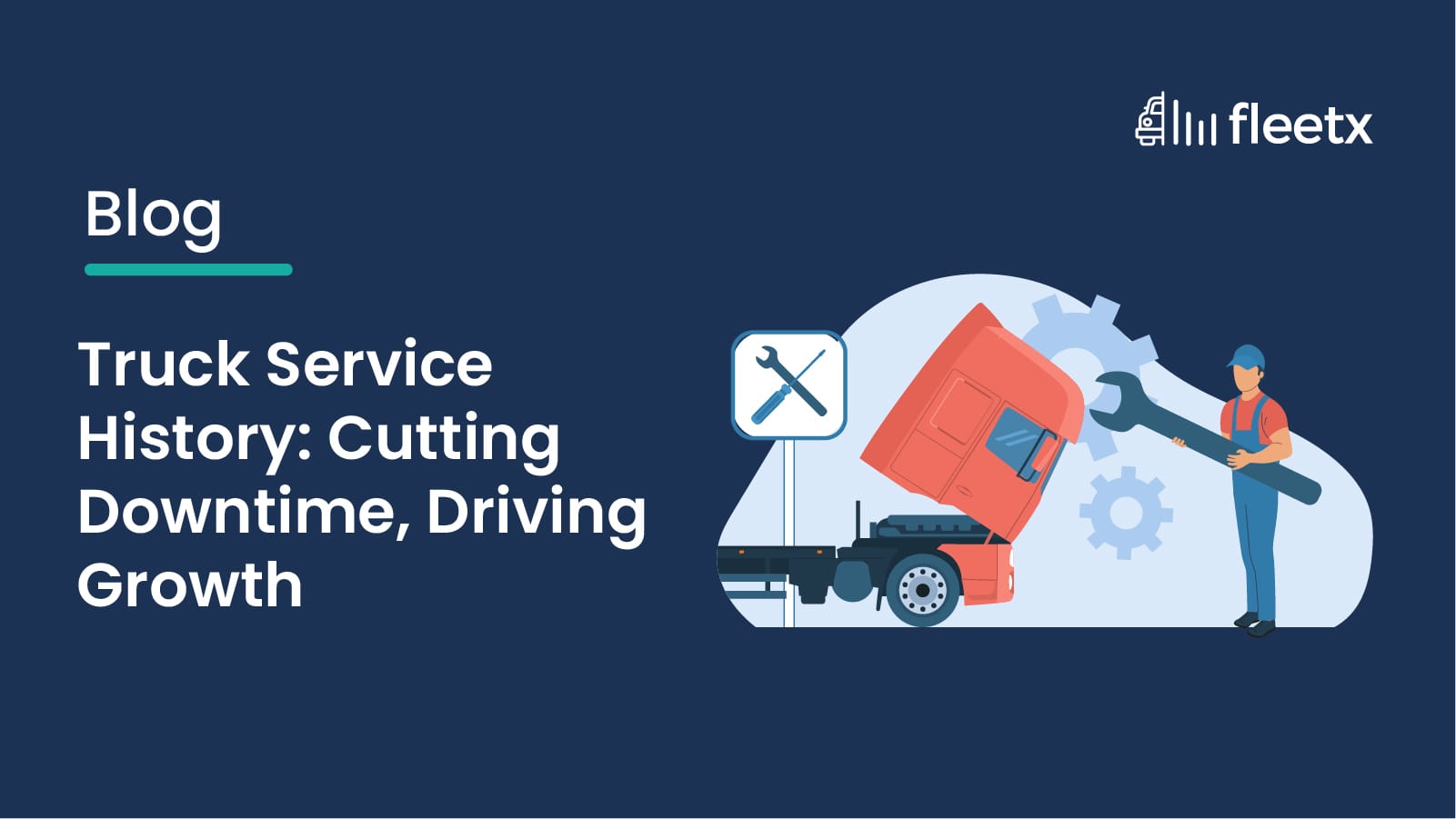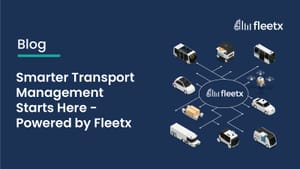
Every trucker knows the bitter truth - an empty truck still burns fuel, eats up time, and adds to operating costs. Industry reports reveal that as high as 40% trucks on Indian highways run empty after delivering a load. These "empty miles" are the silent profit killers for transport businesses.
Enter Trucking Management Systems - digital platforms designed to transform chaotic trucking operations into streamlined, data-driven processes. From reducing fuel wastage to optimizing load capacity, Trucking Management System is more than just software; it’s the operational brain transporters have long needed.
Key Features of a Trucking Management System
Route Planning & Optimization
- Uses real-time traffic, road conditions, and fuel station data to design the shortest, cost-efficient routes.
- Minimizes unnecessary detours that inflate mileage.
Dispatch & Scheduling Software
- Auto-assigns loads to available vehicles.
- Eliminates double-booking and reduces human scheduling errors.
Driver Management
- Digitally maintains driver profiles and training progress.
- Monitors compliance with RTO norms, reducing the risk of penalties.
Fuel Management
- Tracks fuel consumption per trip.
- Identifies anomalies like fuel theft or excessive idling.
Load & Capacity Planning
- Matches the right load to the right vehicle size.
- Prevents underutilization, especially in partial-load trips.
Freight Billing & Invoicing
- Automates billing cycles, reducing paperwork delays.
- Provides transparent, error-free invoicing.
GPS Tracking & Telematics
- Real-time location tracking enhances fleet visibility.
- Telematics data helps monitor vehicle health and driver performance.
Compliance & Regulatory Management
- Keeps digital copies of permits handy.
- Ensures adherence to ELD mandates and transport ministry norms.
Predictive Maintenance
- Uses IoT sensors to predict wear and tear before breakdowns.
- Reduces costly downtime caused by sudden failures.
Safety & Risk Management
- Monitors harsh braking, overspeeding, and reckless turns.
- Creates driver safety scorecards to promote accountability.
Analytics & Reporting
- Provides transporters with a clear view of cost efficiency.
- Identifies trends like recurring empty miles or frequent truck idle time.
Reasons Why Digital Load Optimization is Preferred Over Manual Operations
- Accuracy: Manual allocation is prone to errors, while TMS ensures precise load-matching with vehicle type and availability.
- Speed: What takes hours for dispatch managers can be done in seconds digitally.
- Scalability: A manual approach struggles with large fleets, whereas TMS handles multiple trucks with equal efficiency.
Role of AI and Automation in Reducing Empty Miles for Truck Fleets

- Predictive Demand Mapping: AI forecasts load availability across regions, helping trucks find backhaul opportunities.
- Automated Load Matching: Machine learning algorithms instantly connect shippers with nearby trucks.
- Dynamic Pricing: Automated rate adjustments based on demand-supply balance encourage more efficient trips.
Trucking Management Systems: Integrating Load and Route Optimization to Benefit Transporters
The World Bank estimates that improving Indian logistics efficiency by even 10% can boost the economy by $100 billion.
1. Smarter Load Utilization
Empty or half-empty trucks are like money leaking out of your business. A TMS makes smarter load utilization possible by allowing multiple shippers to share truck space on the same route. Instead of dedicating an entire vehicle to a half-load, the system pools partial shipments headed in the same direction. This maximizes capacity, reduces wasted trips, and ensures that every truck is earning its full potential per mile. For transporters, it’s the difference between burning fuel for half-pay and running a full truck that justifies every kilometer on the road.
2. Real-Time Matching with Market Demand
In a volatile market, demand doesn’t wait for manual phone calls or brokerage networks. A TMS connects directly with freight marketplaces, scanning for available loads in real time. This means a truck that just offloaded in Delhi doesn’t have to sit idle - it can instantly be matched with a new load to Mumbai. This real-time agility allows transporters to minimize downtime, cut down on empty miles, and secure better rates by keeping trucks active instead of parked.
3. Reduced Fuel Wastage
Fuel accounts for up to 45% of operating costs in trucking. Reroutes, deadhead miles, and poor planning elevate fuel costs. With load and route optimization, TMS ensures that trucks are always on the most fuel-efficient paths with minimal detours. This doesn’t just cut costs - it lowers emissions, giving transporters an eco-friendly edge in a world where shippers are increasingly choosing partners with sustainability credentials. Less wasted fuel is both a cost advantage and a brand advantage.
4. Improved Driver Productivity
Drivers lose countless hours waiting for assignments, permits, or return loads. TMS eliminates much of that dead time by aligning routes with available loads in advance. With optimized scheduling, drivers spend more of their workday on the move rather than waiting at depots. This not only increases total trips per driver but also boosts morale, since drivers can expect predictable schedules, fewer frustrating idle hours, and safer driving practices.
5. Cost Transparency for Transporters
When costs are scattered across fuel receipts, manual invoices, and handwritten trip sheets, transporters lose visibility on where money is going. TMS changes that by providing detailed dashboards with real-time data - fuel spend, toll costs, idle hours, and load profitability. Armed with this transparency, business owners can negotiate better with shippers, identify loss-making trips, and make evidence-based decisions about pricing.
6. Route-Specific Compliance Checks
Every state, every shipment type, and sometimes even every road comes with its own regulatory checklist. From hazardous cargo permits to RTO norms, compliance is crucial. A TMS automates these checks by flagging whether a truck has the required permits before it leaves the yard. This reduces the risk of costly penalties, delays at checkpoints, and reputational damage with shippers. For transporters, it transforms compliance management.
7. Faster Turnaround Times
Waiting at warehouses eats into profitability. Trucks that sit idle during loading and unloading are trucks that aren’t generating revenue. By coordinating load availability and driver schedules, TMS cuts these waiting times. This faster turnaround ensures trucks can complete more trips per month, which directly translates to higher revenue for transporters. The efficiency gain also improves relationships with shippers, who value speed and reliability.
8. Data-Backed Strategic Planning
TMS analytics give transporters clear insights into performance metrics: most profitable routes, truck downtime, and driver performance trends. By analyzing this data, businesses can decide whether to lease or buy new vehicles and plan expansion into new regions with confidence.
9. Sustainable Fleet Operations
Sustainability is gradually becoming a contractual requirement. Reducing empty miles through smart load and route optimization cuts fuel consumption and carbon emissions. This makes a fleet more eco-efficient, giving transporters an edge in winning contracts with environmentally conscious clients. Beyond the business advantage, it positions the company as a future-ready player in an industry that’s under pressure to clean up its footprint.
New Road Ahead
For transport business owners, running operations on guesswork is like driving with headlights off. A Trucking Management System doesn’t just reduce costs - it creates a future-ready fleet that is more reliable, compliant, and profitable.
- It keeps your trucks loaded, not idle.
- It ensures every mile driven is a productive mile.
- It turns data into decisions that directly improve the bottom line.
In a market where margins are tightening, smart loads and optimized trips are the competitive edge. The transporters who adopt TMS today will be the ones writing the rulebook for tomorrow’s logistics game.
Why do transporters need a Trucking Management System when traditional methods have worked for decades?
Traditional, manual methods may have worked in the past, but today’s logistics market is faster, more competitive, and unforgiving with costs. With up to 40% of trucks in India running empty after deliveries, relying on phone calls and manual planning results in wasted fuel, idle hours, and shrinking margins. A TMS automates load matching, optimizes routes, and ensures compliance, thus improving profitability.
How does a TMS reduce empty miles and improve profitability?
Empty miles eat directly into margins. A TMS combats this by:
- Matching trucks with real-time available loads through integrated freight marketplaces.
- Pooling partial loads from multiple shippers on the same route.
- Optimizing return trips to minimize deadhead runs.
By ensuring every trip is planned and profitable, transporters save fuel, maximize truck utilization, and increase overall revenue.
What role does AI play in a modern TMS?
AI is the engine that makes today’s TMS smarter. It suggests backhaul opportunities and adjusts freight rates dynamically based on supply-demand balance. AI also monitors driver behavior and vehicle health through telematics, helping prevent accidents and breakdowns. In short, AI doesn’t just react to logistics problems; it prevents them before they cost transporters money.






